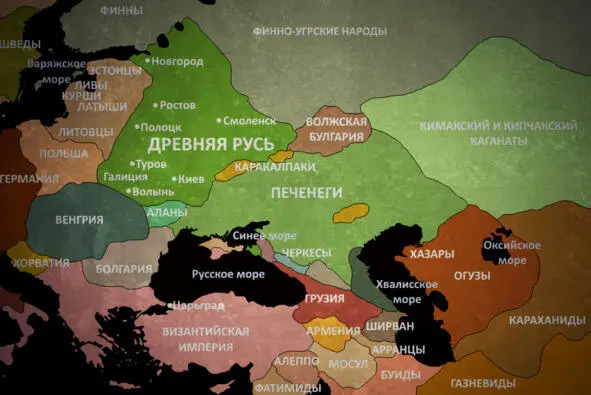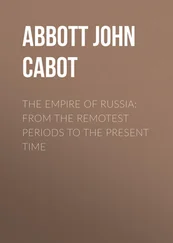…Information about all these state entities is very fragmentary. Often the kaganates are combined both territorially and on a chronological scale. It is only clear that they occupied a significant part of the future Rus, interacted with the Slavic tribes, fought or entered into alliances. The state religion of the Avar and Khazar kaganates is Judaism, fancifully mixed with pagan customs, the Turkic religion is shamanism and Buddhism.
The beginning of the official chronology
…Ninth century AD. Varyag (Viking, Norman), or the Prussian Rurik reigns at the invitation of the people’s veche in Veliky Novgorod, with the brothers Truvor and Sineus. A ruler with a good pedigree, outside of local strife is a worldwide practice to this day.
Some researchers trace the word «Rus» to the Old Icelandic «sailors, rowers». Other historians define it as the self-name of the ancient Baltic (Slavic) people of the Prussians. There is also a version that deduces «Rus» from the ancient Iranian ruksi – «white, light». The name of a single representative of the people initially sounds like «Rusyn».
…Prince Oleg is the regent of Rurik’s son, Igor, seizes the center of trade routes, prosperous Kiev. Then he went with the embassy to Byzantium, where he was first called the Grand Duke in synchronous Byzantine and European sources. Oleg the Prophet dies, as the epics say, from a snakebite.
Prince Igor is for the first time recorded by the Byzantine chronicles as a Russian commander who attacked Constantinople with significant forces – a thousand forty-seat rooks. The Byzantine squadron uses Greek fire. This ancient superweapon destroys most of the Russian fleet. Draw. Peace treaty with the emperor of Byzantium, Roman the First Lacapenus. Diversified trade, political and religious ties are being established.
Where was the base of the first Russian fleet located? Perhaps in Tmutarakan – on the present Taman Peninsula, or in the area of modern Kerch («Korchev»). Crimea at this time was ruled from Taman. Part of the peninsula under the control of the city of Chersonesos, or, in other words, Korsun (within the boundaries of present-day Sevastopol), is controlled by the great Byzantium.
…The prince dies from his greed, trying to re-collect tribute from the Drevlyan tribe. However, the circumstances of the death of the ancient supporter of double taxation are confusing.
Igor’s beloved wife, Olga, the first name of Prekras, is baptized personally by the emperor of Byzantium, Constantine the Seventh. She builds up the government of the country, atones for her sins, is engaged in the upbringing of her son Svyatoslav.

Ancient Russia and other state formations of the 11th century. Rus proper is highlighted in thick green
Svyatoslav is at war with Bulgaria. Then he turns his weapon towards the possessions of Byzantium in Thrace. In 970, the troops of Emperor John the First forced the prince to retreat. Returning, the prince is ambushed by the Pechenegs (a nomadic tribe known until the middle of the eleventh century) and dies.
The next ruler is Vladimir the First Svyatoslavovich, aka Vladimir the Saint, the fruit of Svyatoslav’s connection with a certain almsgiver Malusha. The bastard is brought up under the supervision of Princess Olga.
In 988 another war with Byzantium will take place. Vladimir captures Korsun (Tauric Chersonesos) and concludes a peace treaty. To enter into a dynastic marriage with the sister of the Byzantine emperor Basil II, Anna, here, in the city he captured, the prince is baptized.
The first Kiev metropolitan, attested by written sources – Theophylact. The priest takes under the authority of four bishops – Belgorod, Novgorod, Chernigov, and Polotsk. Theophylact leaves his high post in 1018.
Vladimir Krasnoe Solnyshko is known for his participation in the voluntary-compulsory change of the state religion. He is a character in many folk tales. Under Vladimir the Holy, the church charter was introduced, the minting of «silver coins» began; high quality classic coins that have replaced elongated silver grivnas. Around 980 Vladimir kills Rogvolod, prince of the Polotsk principality (the territory of modern central and northern Belarus). His daughter, Rogneda, he forcibly marries. Three sons from this marriage become an offshoot of the Rurik, Izyaslavich Polotsk or, in other words, Rogvolodovich.
Yaroslav Vladimirovich the Wise, son of Vladimir, prince of Novgorod, Kiev and Rostov. The heyday of the Russian kingdom. Introduction of a set of state laws. Princes and princesses from Yaroslav and his wife, daughter of the Swedish king, Indigerdy are welcomed in France, Hungary, Greece, Norway, Poland and Austria.
Yaroslav achieves the fact that, bypassing the rights of the Patriarch of Constantinople, the Metropolitanate, by a council of bishops, in 1051, is appointed priest Hilarion of Russian origin. However, under the successor of Yaroslav, from 1055 the order of things was restored.
Three centers of power crystallize – Kiev, Vladimir and Veliky Novgorod. Here we can add Polotsk, the capital of the future Belarus. Kiev is an outpost of Russian civilization. Further south, behind the system of the Serpent Shafts erected by someone unknown, are the possessions of the Polovtsy and Mongols, with an island of Russian possessions, Tmutarakan.
The next popular ruler (according to the «ladder» principle of seniority of the princely family, from brother to brother) is Vladimir Vsevolodovich Monomakh, i.e. «Combatant» (1113—1125), grandson of the fifth son of Yaroslav the Wise and the Byzantine emperor Constantine Monomakh, Prince of Rostov, Chernigov, Pereyaslavl, Grand Duke of Kiev. He is known for pushing the Polovtsians away from the borders of Russia (1111, «Crusade» to the Great Steppe), autobiographical texts («Teaching to children», «Chronicle of life»), limiting the arbitrariness of usurers from ex-Khazars in Kiev, freeing debtors.
Less known is the war between the prince and Byzantium, for the interests of the husband of his daughter, the impostor «Leo Diogenes», and then his son (his grandson). There is an opinion that in a series of fierce and, in general, unnecessary battles, Vladimir is depleting the potential of his country, preparing it for a period of fragmentation and decline.
In the twelfth century, from the death of the last strong ruler, Mstislav the Great, the son of Vladimir Monomakh, from the clashes between princes Andrei Volynsky and Yuri Dolgoruky, the Civil War begins. Mstislav’s daughters marry prestigious European kings – Norway, Hungary, Denmark. Then the popularity of matchmaking in these parts of the royal blood falls.

The onslaught of the Mongols is so strong that the desire to resist them quickly disappears. So, the city of Ryazan, the capital of the flourishing Ryazan principality after the assault in 1237, is still a desolate flat hill. Central Europe is less centralized. Each feudal lord has his own stone castle. It is much more difficult for foreign conquerors to collect tribute in such territories.
Russia is divided into fifteen or eighteen principalities, with their own dynasties, or even without them. Veliky Novgorod, by decision of a mixed boyar and folk veche, invites the most worthy princes. His example is followed by three principalities, choosing to reign the younger sons of the main dynasty who have remained out of work. In Kiev, the thrones governing certain lands work side by side, reminding the Federation Council.
Читать дальше














